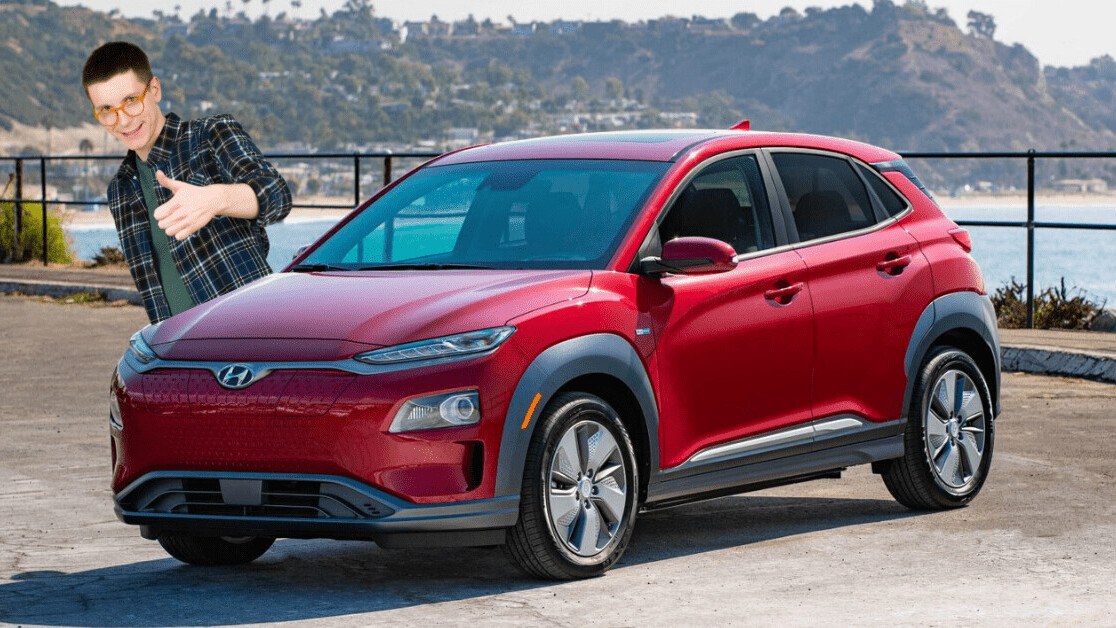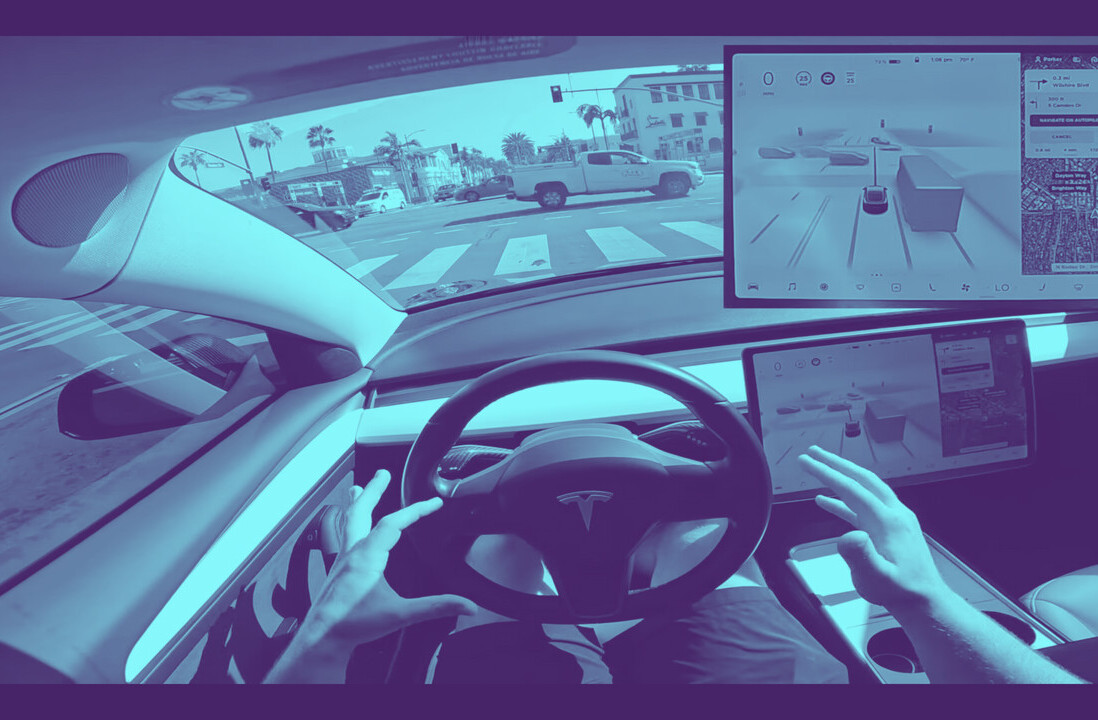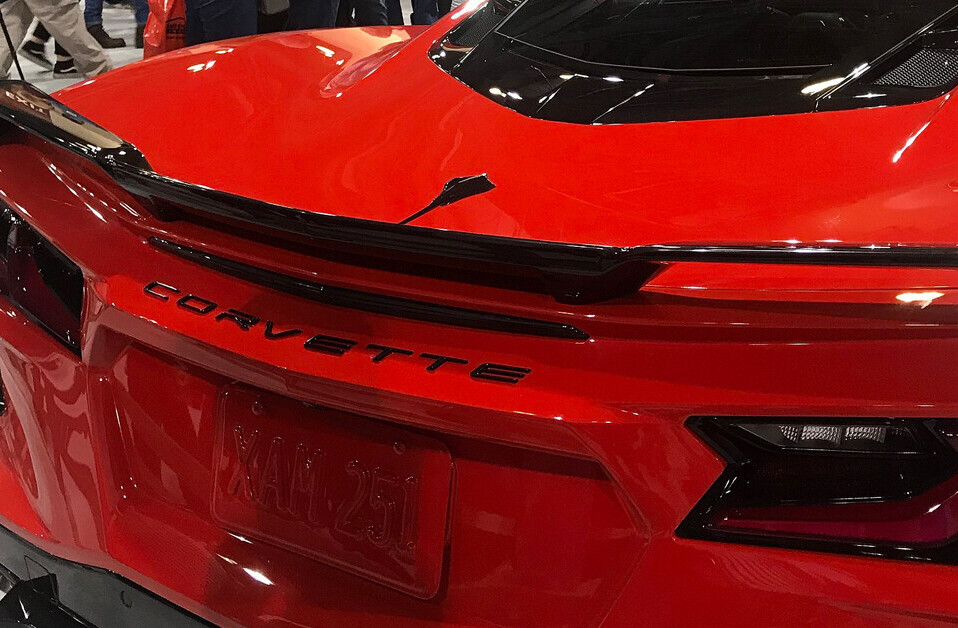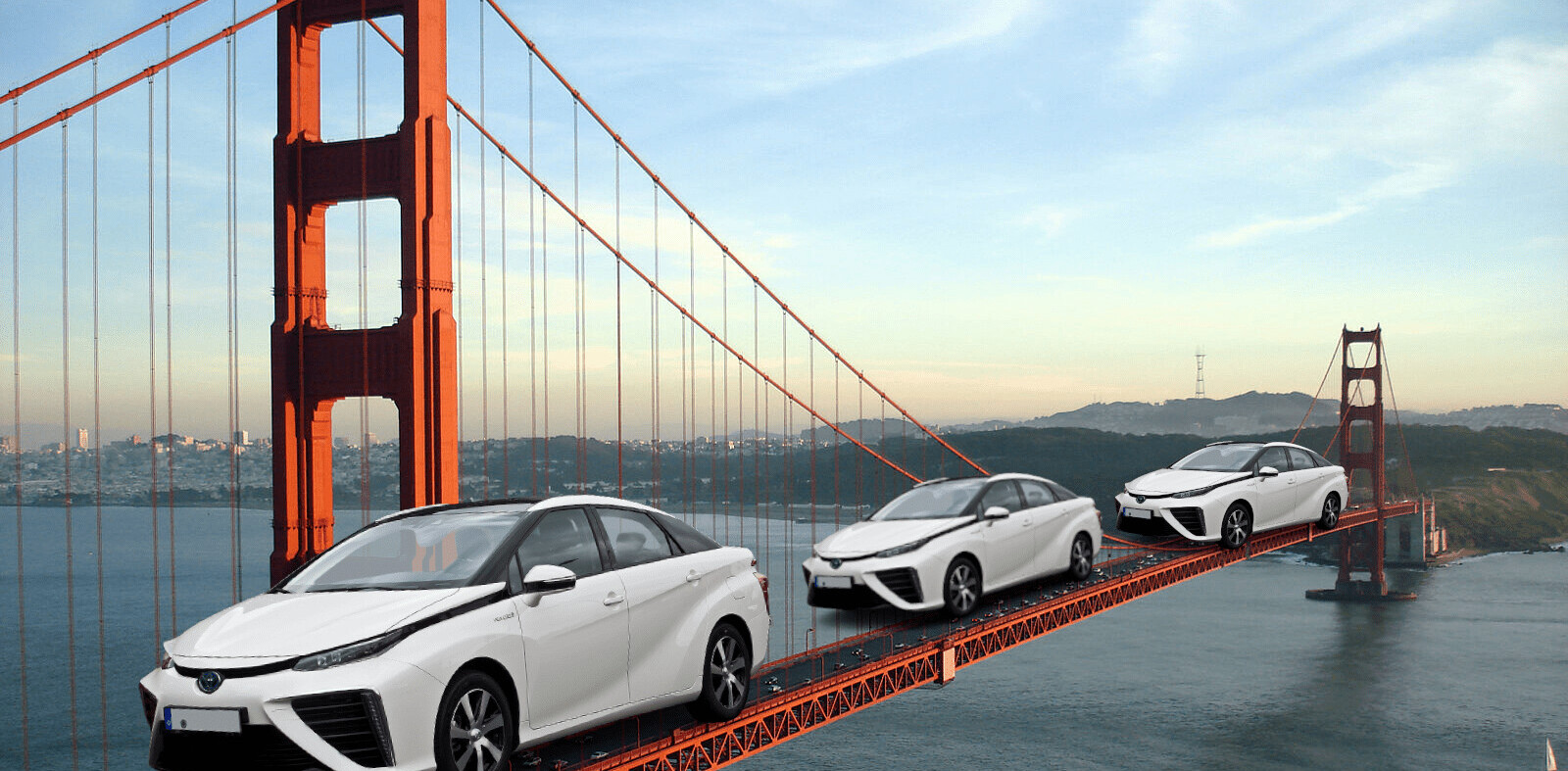This article was originally published by John Faulkner on Clean Fleet Report, a publication that gives its readers the information they need to move to cars and trucks with best fuel economy, including electric cars, fuel cells, plug-in hybrids, hybrids and advanced diesel and gasoline engines.
Hyundai got it right when they designed the Kona EV as a crossover SUV, which is the hottest segment in the market and shows no signs of slowing down. The 2020 Hyundai Kona EV Ultimate hits all the sweet spots for anyone looking for versatility, style and a 250+ mile electric driving range. The Tesla Model 3 has sold very well as a sedan, but even Tesla is coming out with a compact crossover SUV, so Hyundai certainly was on to something and ahead of the pack.

Smooth operator
The front-wheel drive (all-wheel drive is not an option) Hyundai Kona EV motor produces 201 horsepower and 290 pounds-feet of torque, consistently turning in 0-to-60 times around 6.5 seconds. But when zipping around town, and especially in the Sport mode, the Kona EV felt quicker than that. For more conservative driving with an eye on achieving the EPA’s estimated driving range of 258 miles, the other driver-selectable modes are Eco and Comfort. Eco is the default setting, where you want to be for those extra-long freeway runs, where performance gets in-line behind driving range.
The liquid-cooled 64-kilowatt-hour lithium-ion polymer battery pack is replenished through plug-in charging and regenerative braking. The regenerative charging system converts kinetic energy into electric energy, when applying the brakes or coasting, and stores it in the battery. This process can be viewed on a dash gauge where you can watch the power flow into and out of the battery and engine.

The Kona EV also has the ability for one-pedal driving by using the steering wheel mounted paddles. By pulling on the left paddle the Kona can be brought to a complete stop, without touching the brake pedal. If you keep the pedal pulled tight, the car will not creep, then will only move when stepping on the accelerator. The value to this is the battery replenishes faster than using the brakes, as the motor is doing all the slowing. It takes a bit of practice to modulate the slowing, but when mastered it makes rush hour, stop-and-go traffic a new experience not having to hit the brake pedal. Note: This is one reason electric vehicle maintenance is less than a comparable gasoline-powered car, as brake pads don’t wear out nearly as fast.
There are three plug-in charge levels which can be controlled manually, or by the Blue Link connected car system, to set the day and time of recharging. From near empty to a full charge, times are:
- 120V (Level 1) – 17 hours (using the 7.2 kW onboard charger)
- 240V (Level 2) – 9.5 hours (using the 7.2 kW onboard charger)
- 480V DC 50 kW Quick Charging – 75 minutes
- 480V DC 100 kW Quick Charging – 54 minutes
Driving experience: on the road
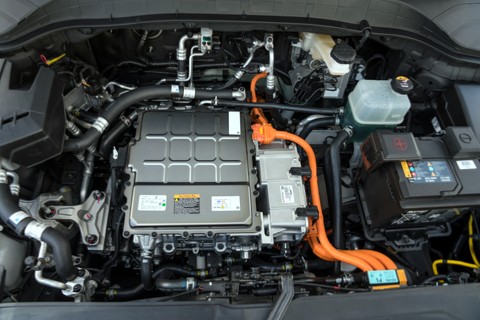
The well-distributed 3,800-pound weight gave the Kona EV a solid and confident ride. The under-seat battery placement created a low center of gravity and resulted in very good driving dynamics. The motor-driven power steering was well-tuned for road feel with maneuvering in town, especially parking, being easy. Tire and wind noise were at a minimum; the 17-inch alloy wheels and 215/55R Nexen low-rolling resistance tires barely transmitted noise to the cabin. When pushing corners a bit too fast, there was minor body roll. The regenerative braking system has four-wheel disc brakes with ABS and brake assist. The stops were straight and true with no brake fade and a pleasant hybrid braking whine when stopping.
That other noise you hear, when driving under 20 miles per hour, is a soft sci-fi whirring sound, part of the pedestrian warning system. Consisting of a speaker mounted behind the front bumper, this futuristic sound lets pedestrians know the Kona EV is close by. Without it, there is no sound at all coming from this all-electric crossover, making it too stealthy when approaching an occupied crosswalk.
Driving Experience: In and Out
The Kona EV exterior design is smooth with very few sharp angles. The rounded front end is highlighted by the closed-off grille with a cross-hatch pattern; the charge door is in a far more convenient location than when placed on either fender (as several automakers do). The LED headlights, with LED daytime running lights located in the bottom fascia, complete the sleek front end.
The appealing side view has a gently sloping roof with rack rail tracks, a color-keyed shark fin antenna and an integrated spoiler over the rear hatch window. The horizontal LED taillights and minimal chrome (on the Hyundai badge and an eyebrow strip over the license plate) finish off the attractive rear. A very simple “Electric” badge on the lower right corner of the hatch softly states the Kona EV is silently and cleanly driving ahead.
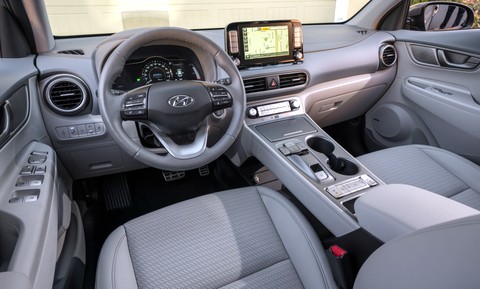
Climbing inside, the cabin includes ample leg and headroom for two six-footers up front; the rear seat is a bit tighter on space, especially for three adults. Clean Fleet Report was driving the 2020 Kona EV Ultimate, which came standard with leather-trimmed heated and ventilated front seats. The driver’s seat is eight-way power adjustable with lumbar, while the passenger gets manual adjustments. We like that the outlook on the road, with 6.2-inches of ground clearance, was higher than a sedan, but not as high as an SUV. The rear seat center armrest has cup holders; if there are no passengers out back, fold down the 60/40 split rear seat for additional storage area.

Other features are a power tilt and slide sunroof, a head-up display, Homelink auto-dimming rear view mirror, heated and power side mirrors with turn signals, USB ports, wireless charging, and rain-sensing windshield wipers.
The center dash in our Kona EV Ultimate came with an 8.0-inch touchscreen housing navigation, and an eight-speaker, 315-watt Infinity sound system with a subwoofer, playing AM/FM/CD/MP3/AUX and Sirius/XM. Android Auto and Apple CarPlay, with smartphone integration via Bluetooth, complete the audio system. The leather-wrapped and heated steering wheel has controls for audio, telephone and cruise control. Big thanks to Hyundai designers for the knobs and wheels to control the radio and automatic temperature control.
Safety and warranties
The 2020 Hyundai Kona EV comes with an extensive and impressive list of standard safety features. They include front, seat and side-impact airbags, forward emergency braking and collision warning, stability control, smart cruise control with stop and go, blind spot collision monitoring, park assist with front and rear sensors, vehicle stability management, traction control, hill start assist, tire pressure monitoring system, motor immobilizer, lane departure warning and rear cross traffic alert.
The Kona EV has not been rated by the National Highway and Safety Administration (NHTSA) or The Insurance Institute for Highway Safety (IIHS). However, its gasoline-powered siblings are a Top Safety pick with the IIHS, the highest rank. The NHTSA gave it a 5 Star rating, also their highest mark.
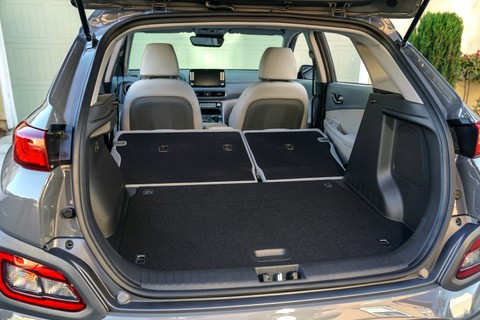
The 2020 Hyundai Kona EV comes with these warranties:
- Battery – Lifetime/Unlimited miles (transferable)
- Powertrain – 10 years/100,000 miles
- New Vehicle – Five years/60,000 miles
- Roadside Assistance – Five years/Unlimited miles
- Anti-perforation – Seven years/Unlimited miles
Pricing
The 2020 Kona EV comes in three trim levels, with each having an increased number of features and accessories. There are actually only eight a la carte accessories available to be added to one of the trim levels. The base price for each model is:
SEL $36,990
Limited $41,600
Ultimate $45,200
Clean Fleet Report’s 2020 Kona EV Ultimate had a MSRP of $45,335. All prices do not include the $1,095 freight charge.
The Kona EV qualifies for federal and state credits, and in some states, is eligible for a HOV sticker.
The 2020 Kona is available in the ZEV (Zero Emission Vehicle) states: CA, CT, MA, MD, NJ, NY, OR, WA, RI, WA, VT.
Observations: 2020 Hyundai Kona EV Ultimate
Hyundai is all-in with vehicle electrification, and Clean Fleet Report is glad they are. We have reviewed all their hybrid, plug-in hybrid, electric and hydrogen fuel cell vehicles, and have been impressed with them all.
For versatility, ride, style, range and standard safety equipment, the 2020 Hyundai Kona EV is hard to beat. Before visiting your Hyundai dealer, do some homework on the competitors, talk with your tax advisor for clarity on the federal and state credits, and then make an appointment to meet with a Hyundai factory trained electric vehicle specialist.
Then, don’t be surprised if you drive home in a Kona EV.

Whatever you buy, Happy Driving!
Make sure to opt-in to the Clean Fleet Report newsletter to be notified of all new stories and vehicle reviews. You can follow Clean Fleet Report on Twitter and Facebook.

Get the TNW newsletter
Get the most important tech news in your inbox each week.
